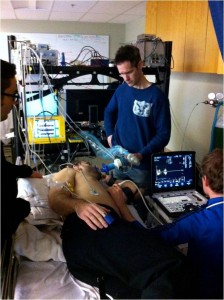My first lead author publication! A sexy paper on hot physiological topics. By mitigating hypoxic pulmonary vasoconstriction with the administration of acetazolamide, can we prevent intrapulmonary shunting? Nope, shunt vessels appear to be hypoxia-mediated. Insightful and innovative, although unfortunately data collection preceded my arrival. My contribution included data and statistical analysis and the drafting of the final manuscript now accepted for publication in the Journal of Physiology. As a naïve MSc student at the onset of this project, I now feel more comfortable with the scientific method and the processing of scientific data. My first forage into scientific data analysis and writing was difficult but I now find it much more manageable to decipher scientific literature and to work with complicated analysis software. The single greatest challenge faced writing the manuscript was how to interpret an unexpected finding. Enter acetazolamide, a drug that most notably ruins beer by eliminating “the tingle of carbonation” by slowing the conversion of carbon dioxide. Unconcerned with the subject’s post-study pub experience, our team of researchers used acetazolamide to blunt the rise in pulmonary artery pressure typically observed with hypoxic exposure. Intrapulmonary shunt vessels tend to be dormant in resting conditions breathing room air and were once theorized to act as pop-off valves, being popped opened by elevated pressures. Another possibility was that hypoxia sends a biochemical signal that promotes blood flow through these vessels. The elegance in this study, as you can hopefully appreciate, was that administering aceta zolamide permitted the observation of hypoxia without the accompanying rise in pulmonary vascular pressure. Methodological separation of proposed stimuli: classic mechanistic physiology. Unbeknownst to the research team, the subjects were low responders to hypoxia, meaning they displayed only modest increases in pulmonary artery pressure. With modest rises comes modest blunting and a modest difference between trials, making interpretation tricky. Check out the article to see how these findings were addressed and let us know if you agree or disagree with our interpretations. As for me, well it’s about time that I get my hands dirty in the lab and start working on my thesis!
zolamide permitted the observation of hypoxia without the accompanying rise in pulmonary vascular pressure. Methodological separation of proposed stimuli: classic mechanistic physiology. Unbeknownst to the research team, the subjects were low responders to hypoxia, meaning they displayed only modest increases in pulmonary artery pressure. With modest rises comes modest blunting and a modest difference between trials, making interpretation tricky. Check out the article to see how these findings were addressed and let us know if you agree or disagree with our interpretations. As for me, well it’s about time that I get my hands dirty in the lab and start working on my thesis!
Josh on Becoming an Author
Reply

